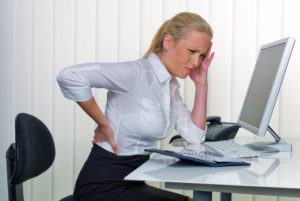Sitting, standing and sleeping in poor postural positions affects the function of the musculoskeletal system and can lead to aches and pains. Here are some quick and easy posture tips from The BioMechanics Method to help lesson the negative effects of sitting, standing and sleeping incorrectly.
Sitting Posture Tips
- Get out of your chair several times a day to help extend (i.e,, straighten up) the hips, legs and spine.
- Change your workspace to a standing desk or walk when possible instead of driving.
- Change chairs and sitting positions often or alternate sitting on a gym ball with your office chair.
- Check and/or adjust the positioning and alignment of your computer monitors, telephones, steering wheels, chairs, televisions, computer accessories, and keyboards.
Standing Posture Tips
- Be aware of habits like shifting your weight from side to side when standing (i.e., propping your weight on one leg/hip).
- Make good footwear choices. (i.e., don’t stand around in high heels or tight fitting shoes).
- Change bad habits like crossing the arms, talking on the cell phone, carrying a heavy bag on one shoulder, or putting hands in your pockets (these habits can all create problematic shifts in body position and posture).
Sleeping Posture Tips
- Sleep on your back on a bed that is firm enough so that your back doesn’t sink into the mattress.
- If your lower back feels uncomfortable lying on your back place a wedge or pillow(s) under your knees. (This will help keep the lower back and pelvis nearer its optimal position.)
- Choose a pillow thickness that puts your eyes in a position that is perpendicular to the ceiling (but ensure that the pillow thickness is not so great that it pushes your head too far forward).
- If you choose to sleep on your side, place a pillow between your knees to help keep your leg in line with your hip socket. Also, the pillow you use for your head should be thick enough to keep your head in line with your spine when lying on your side.
Remember: As you incorporate these posture tips be sure to make any changes gradually to give your body time to adapt to these new habits.
Fitness, exercise and health professionals interesting in learning a step-by-step process for assessing client posture and helping them overcome muscle and joint pain can choose to enroll in the industry’s highest-rated Corrective Exercise Specialist certification course from The BioMechanics Method. To learn more about this amazing program click on the image below.


